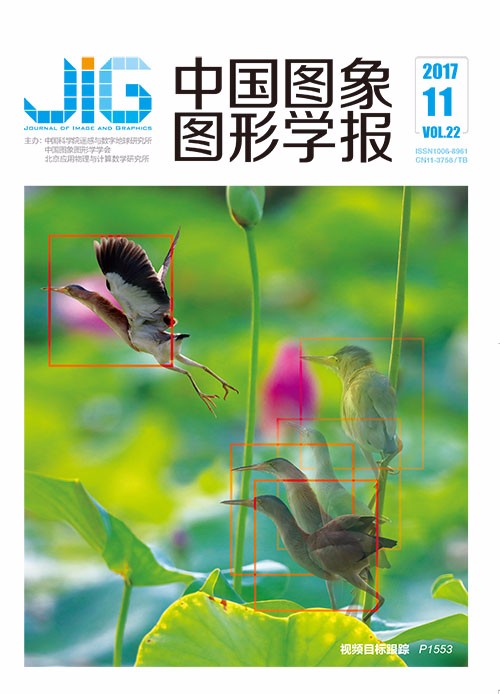
从阴影恢复形状的径向基函数反射模型研究
摘 要
目的 为解决传统阴影恢复形状(SFS)算法由于光源方向初始信息估计不准确,恢复的物体表面过于光滑,3维表面形状误差较大等问题,建立了基于径向基函数神经网络的反射模型,并对传统的神经网络进行了改进。方法 建立的基于径向基函数(SFS)神经网络的从阴影恢复形状反射模型代替了传统方法中采用的理想朗伯体表面反射模型。该模型利用径向基函数优秀的局部映射和函数逼近能力来处理SFS问题,通过网络训练过程中的权值代替物体所受到的初始光源信息,解决了传统算法在进行计算时,必须已知光源参数的限制。在该网络模型中添加自适应学习率算法,加速网络的收敛和训练速度。结果 针对SFS问题处理的两幅经典合成图像以及两幅实际图像进行了实验,实验结果表明,改进后的算法在3维视觉效果和3维形状信息的恢复方面都明显优于传统算法。归一化后的3维高度误差结果相比传统算法缩小了60%以上,而且同时适用合成图像和实际图像;自适应学习率的加入,使得网络的训练速度大大加快,对一幅128×128像素的图像,运算速度提升了50%。结论 本文针对SFS问题建立了基于RBF神经网络的从阴影恢复形状反射模型,利用网络模型中的参数代替SFS问题中的初始光源信息,通过最优化方法求解SFS问题。并针对传统的神经网络固定学习率造成网络收敛速度慢,容易陷入局部极小值的问题,加入了自适应学习率算法。实验结果表明,改进后的算法在处理该SFS问题时表现了优秀的性能,适用范围更广,收敛速度更快。
关键词
Radial basis function reflective model of shape from shading
Yang Zhiming, Zhao Hongdong(Tianjin Key Laboratory of Electronic Materials and Devices,School of Electronics and Information Engineering, Hebei University of Technology,Tianjin 300400,China) Abstract
Objective The traditional shape from shading (SFS) algorithms inaccurately estimate the initial information of the original direction of the light source,thereby causing the reconstructed surface to be smooth in several objects with a rough surface.The ideal reflection model,i.e.,Lambertian surface,is too simple to meet the conditions in real applications.Therefore,the reconstructed shape of the object presents serious errors.In this study,a reflection model based on the radial basis function (RBF) neural network is established to solve this problem.Moreover,the fixed learning rate in the traditional algorithm slows down the training process.Thus,the neural network is improved in the aspect of learning rate to accelerate the training speed and avoid being trapped in a local minimum at the same time.Method The reflection model,which is based on the RBF,replaces the ideal Lambertian reflection model used in the traditional SFS algorithms.The excellent local mapping and function approximation capabilities of the RBF are suitable for dealing with the classic SFS problems.The original information of the light source is replaced by the weight in the training process of the RBF neural network.Then,the SFS problem is transformed to obtain the optimal solution for its energy equations.In this manner,the limitation that the direction of the light source parameters must be known in the beginning is removed.Only one single image is needed in the improved algorithm to restore the 3D surface of the target object.However,the fixed learning rate in the traditional neural network easily causes the local minimum when the parameters are inappropriate in the beginning and slows down the training speed in practice.Therefore,the adaptive learning rate algorithm is added to the network to accelerate the convergence and training speeds.The learning rate can be automatically adjusted from the iterations.Result In the experiments,two synthetic images for the classic SFS problems are Vase and Mozart and two real images are Map and Antique.The four images are used to test the improved algorithms.Then,the 3D visual effects and the quantitative comparison of the results are conducted.The experimental results show that the results of the improved algorithm in 3D visual effects are better than those of the traditional SFS algorithms.The reconstruction of the 3D shape information is apparently superior to that of the traditional algorithm.The traditional SFS algorithms always show serious errors in real images.The traditional algorithms show some errors in details in synthetic images.The improved algorithm using RBF performs well when dealing with the synthetic images and yields improved results when dealing with the real images.The min-max normalization function is introduced to deal with the height information to compare the absolute errors clearly.According to the comparison of the normalized 128 pixels height error from the map,the result of the normalized 3D height error using the improved algorithm decreases by more than 60% compared with the traditional SFS algorithms.The entire calculation process of the improved algorithm takes 50% less time than that of the traditional algorithms.Moreover,the improved algorithm is appropriate for synthetic and real images simultaneously.Conclusion The ideal Lambertian reflection model cannot easily meet the needs in practice because the assumption that the Lambertian surface reflects light in all directions is inaccurate in real application.Therefore,the results of the objects with rough surface using the traditional SFS algorithm exhibit many errors.The Lambertian reflection model is only suitable for some synthetic images with a smooth surface.However,for the real images,the reconstructed 3D surface cannot be precise when using this model as it causes serious errors in the shape of the restored images and the 3D visual effect is poor.With some real images,such as Map,the basic shape of mountain can be barely distinguished.The RBF is introduced to the SFS problems to establish a new reflection model to solve this problem.The reflection model based on the RBF replaces the original direction of the light source by the weight in the neural network.By training the relevant parameters in the network,the improved algorithm overcomes the shortcomings of traditional methods,e.g.,the inaccurate estimation of the original light source.The new reflection model is suitable for synthetic and real images and shows excellent 3D recovery capability in real images with rough surface.Moreover,the adaptive learning rate algorithm accelerates the training speed,thereby obviously improving the work efficiency.The training time of the new reflection model is 50% less than that of the traditional algorithm.The maximum absolute error value of the new reflection model is reduced by more than 60% compared with the traditional SFS algorithm.In this study,the improved algorithm is applicable to the 3D reconstruction of surfaces in most non-high-precision situations,without the need for the initial information of the direction of the light source.
Keywords
|



 中国图象图形学报 │ 京ICP备05080539号-4 │ 本系统由
中国图象图形学报 │ 京ICP备05080539号-4 │ 本系统由